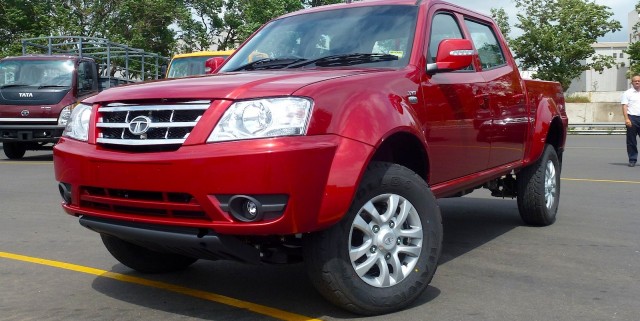
The Tata Xenon will aim to offer an unrivalled blend of toughness and value when it enters Australia’s burgeoning ute segment in mid October.
Pricing of the six-variant Xenon line-up – comprising cab-chassis, single-cab and dual-cab body styles in 4×2 and 4×4 layouts – is still to be finalised, but will fall between $20,000 and $35,000.
At that level, it will challenge the likes of the ageing Mitsubishi Triton and slow-selling Ssangyong Actyon Sports. It will also be positioned above cut-price rivals from China (Great Wall X200) and its own backyard (Mahindra Pik-Up), but undercut the market’s ‘new-generation’ utes (think Ford Ranger, Mazda BT-50, Toyota HiLux and Volkswagen Amarok).
Built and sold in India since 2007 and exported to select markets in Europe, the Middle East, Brazil and South Africa, the Tata Xenon will become the first vehicle imported by Fusion Automotive, the new local distributor of the subcontinent’s largest automaker.
The Xenon will initially launch with a limited safety package featuring only two front airbags and anti-lock brakes, though an upgrade in early 2014 will add electronic stability control, traction control and hill-hold assist as standard. The lack of a proper lap-sash seatbelt for the middle rear seat (it gets a lap belt only) in the dual-cab version is unacceptable in this day and age, however, as is the lack of side and curtain airbags, and Tata has no current plans to amend either situation.
A single engine and transmission option simplifies the tyre-kicking process for potential customers. The Xenon teams a 2.2-litre four-cylinder direct injection turbo-diesel engine with a five-speed manual transmission. The Tata-designed and -built engine produces 110kW of power at 4000rpm and 320Nm of torque at 1700-2700rpm.
Fusion is yet to release official fuel consumption data, though it highlights that the engine complies with Euro 5 emissions regulations. Towing capacity is fixed at 2500kg across the range, which leaves it 1000kg short of the class leaders.
Two laps of Tata Motors compact test track at its development, testing and production hub in Pune, India, is far from sufficient for a thorough assessment of the Xenon’s ability, though it is enough for the engine to prove its competency.
Power delivery is strong across a usefully broad range spanning just south of 2000rpm up to 4000rpm. Whistles and rasps enter the engine note on the approach to its redline though effective sound insulation ensures the cabin is protected from serious aural unpleasantness.
Our two test vehicles were among first Australian-spec cars to roll off the production line, and were yet to complete final tests and alignment checks.
Tata offered this as explanation for inconsistencies in the cars’ steering weight – one was very light, the other noticeably heavier, potentially a side effect of differences in tyre pressures. Despite a slightly notchy feel to the heavier-steering test car, both displayed encouraging linearity as lock was applied.
Limited time behind the wheel on the mostly smooth circuit didn’t scratch the surface of the Xenon’s much-hyped toughness either, though a drive on local roads in October promises to put Tata’s claims to the test.
Despite sharing similar dimensions to the HiLux, the Xenon’s cabin feels tighter; noticeably thinner and offering less legroom for rear-seat passengers.
The utilitarian interior features predominantly hard-wearing plastics, some of which come together crudely with rough joins and crevices between panels of varying depths, though the feel and finish is acceptable for a work ute designed for rough and tumble. A deep glovebox and useful door bins and central cup holders are extra ticks in the Xenon’s practicality box.
The seats are firm and lack side support, though this circa-180cm tester had no problems getting settled behind the tilt- but not reach-adjustable steering wheel.
The standard inclusion of air conditioning, electric windows, one-touch triple-flash indictor repeaters, USB input and Bluetooth phone connectivity with audio streaming is welcome (our test cars were still to be fitted with audio systems), though cruise control is absent from the options list that includes rear parking sensors, a reversing camera and a seven-inch screen with satellite navigation.
The Tata range will be offered with a three-year/100,000km warranty and a free roadside assistance package. A capped-price servicing program won’t be announced at launch, but is expected to be applied to the Xenon’s 12-month/15,000km intervals at a later date.
The Tata Xenon is unlikely to appeal to those charmed by the refinement of Amarok and Ranger class, but it could prove attractive as a budget proposition if Fusion can keep pricing to the lower end of its targeted $20,000-$35,000 bracket.

